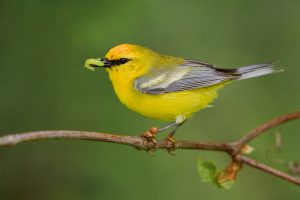A UNC biologist builds a comprehensive online database of North American bird diets.

It all started with caterpillars. UNC biologist Allen Hurlbert has long been fascinated with small forest songbirds, many of which peck and gobble caterpillars seasonally. And it was these small packets of protein and fat — perfect for certain birds — that spurred him to create the first comprehensive database of North American bird diets.
“I’m an avian ecologist,” said Hurlbert, a professor of biology in the College of Arts & Sciences. “Which means I spend a lot of time in the woods measuring the availability of bird food. We do a lot of insect surveys — like the citizen science project Caterpillars Count! — in particular.”
Many songbirds are insectivorous; their diet is exclusively insects. But not all insectivores are the same. “Some songbirds may be more specialized on caterpillars or spiders, while others eat a wide variety of insects,” he said. “And as I was measuring this in the forest, I realized that I needed a more detailed understanding of bird diets.”
And that’s when Hurlbert stumbled upon a vexing problem.
“The literature on bird diets is really scattered,” Hurlbert said. “And many scientific authors use very different methods for reporting bird diet items, so it’s hard to compare apples to apples across various studies.”
He found that trying to understand the detailed diet of a particular bird often means stitching together various studies from the past century or more, or scouring studies conducted over large geographical areas and in different seasons and habitats. Worse, some studies reported what birds ate based on the weight of each item from the bird’s stomach, while others reported the number of items found.
Couldn’t information about bird diets be synthesized into a single source?
The question led Hurlbert on a 12-year journey that recently culminated in the publication of the Avian Diet Database. The online portal lets anyone explore a comprehensive database that can be queried by food item or bird name. A companion article was published Oct. 4 in the journal Scientific Data that describes how the database was created.
The project includes 759 species, 993 studies and 73,075 records. And it’s growing.

Birds are what they eat, too
Knowing a bird’s diet can help researchers answer an array of questions.
“What a species eats is one of the most fundamental aspects of its ecology,” Hurlbert said. “Diet determines to some degree where it can live, who it competes with and what sensory adaptations might be most important for it.”
For example, birds that hunt from the sky have particular wing shapes. And woodpeckers and nuthatches have distinct feet and tail feathers that let them capture insects while clinging to bark. And almost every bird has a different bill shape that reflects how and what it dines upon.
The diet database could help researchers to answer questions such as:
- Do species vary in their degree of diet specialization?
- Do closely related species eat similar things?
- How does a fine-scaled understanding of a bird’s diet connect to its body and bill shape?
- How has a particular bird species’ diet changed over time?
- How does a bird species’ diet vary across its geographic range?
A flock of surprises
The project yielded several quirks. Perhaps the most surprising was that caterpillars are on the menu of seabirds. Yes, seabirds.
“Seabirds like the black-footed albatross come to land to nest, and sometimes there may be some grass or vegetation near a nest,” Hurlbert explained. “Caterpillars are not a huge part of their diet, but it was interesting to see them listed at all.”
Hurlbert’s undergraduate co-authors, Melissa Sawyer (biology ’21) and Patrick Winner (environmental sciences ’18) entered over 30,000 records and helped clean and standardize records compiled by over two dozen undergraduates over the years.
They found diet records for the extinct passenger pigeon from 1840 (it ate a lot of oak acorns), and the Carolina parakeet which went extinct in 1918.
The database can be freely accessed, which is good news for those who picked up birding during the pandemic and want to continue to feed their curiosity.
UNC computer scientist Jeff Terrell led a team of students in the project-based COMP 523 course in designing the web interface.
How diet analysis has changed over time
In the past, ornithologists shot birds, both for their skins and to study their stomach contents. But the passage of time has led to kinder methods.
Today’s researchers can give an emetic to a caught bird that will cause it to regurgitate food. And DNA sequencing of bird excrement can reveal a molecular trail of food that passed through its bowels.
Hawks and owls cough up pellets that contain fur and bone. These can be found near their roosts and nest sites, and they are an insightful and noninvasive way to study a bird’s diet.
Expanding the database’s scope
Hurlbert says his lab plans to expand the database beyond North America.
“There are global compilations for all 10,000 bird species in the world,” he said. “But they have been categorized into these broad descriptions of omnivore and insectivore. But you can be a generalist insectivore that eats any insect you come across. Or you can be a specialist that eats only grasshoppers.”
Hurlbert plans to use the Avian Diet Database to answer some of his long-standing questions about forest songbirds, diet and body shape. There are, after all, many things left to discover about birds and caterpillars.
By DeLene Beeland, College of Arts & Sciences
